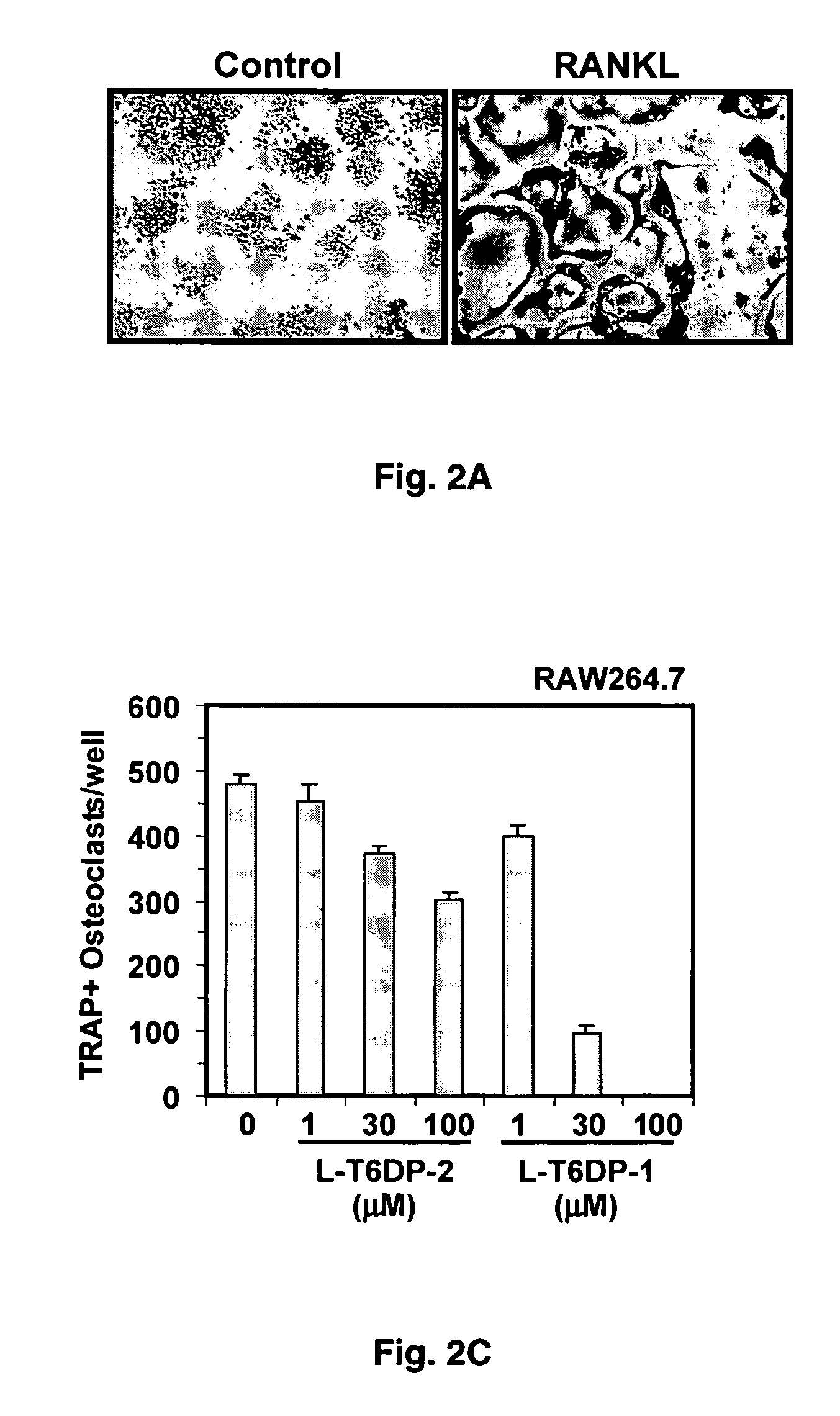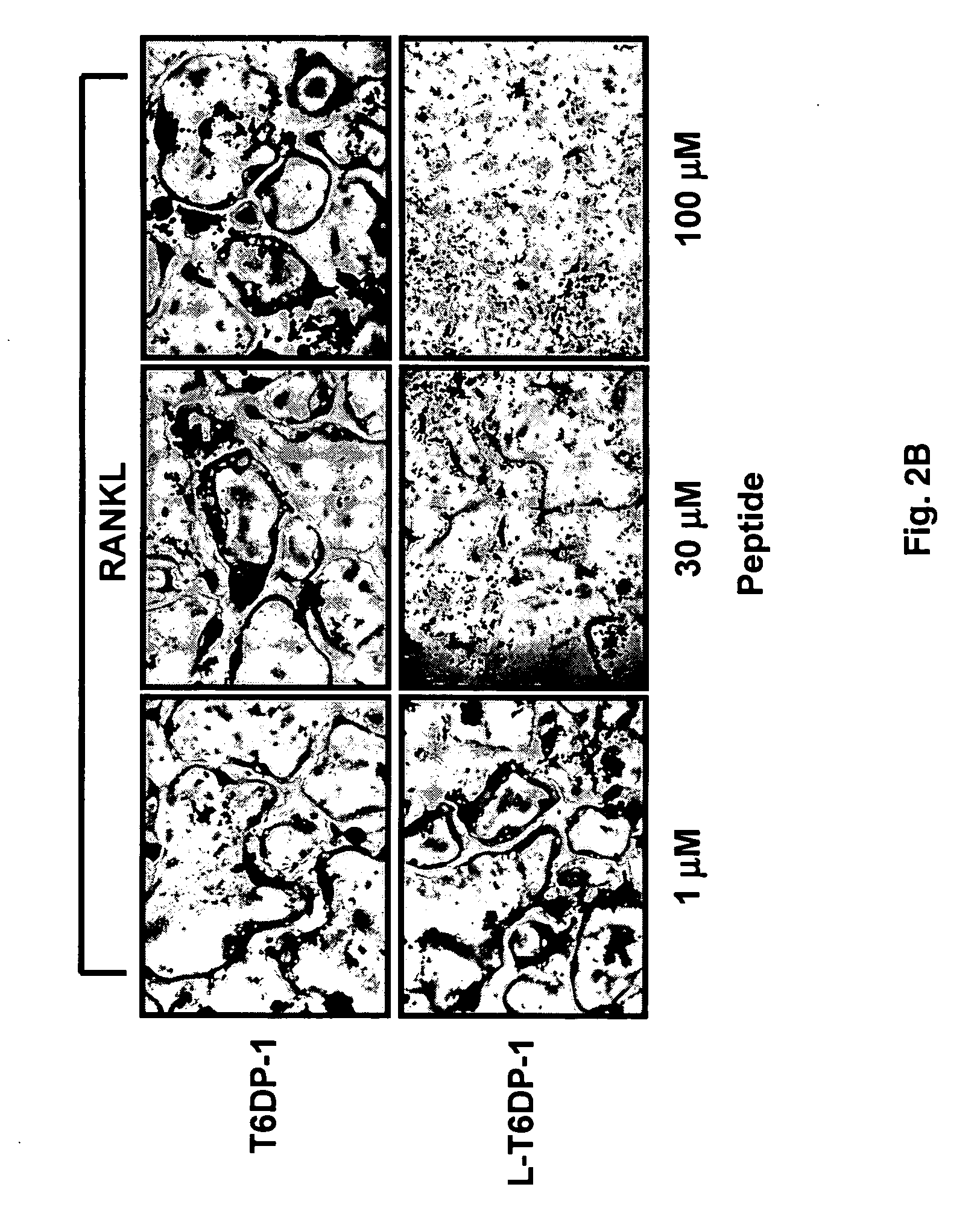Inhibitors of receptor activator of NF-kappaB and uses thereof
a receptor activator and inhibitor technology, applied in the direction of enzymology, peptides, drug compositions, etc., can solve the problems of not completely eliminating the activation of nf, and affecting the resorption of bone resorption by cells
- Summary
- Abstract
- Description
- Claims
- Application Information
AI Technical Summary
Problems solved by technology
Method used
Image
Examples
example 2
[0066] Expression Plasmids
[0067] Expression plasmids encoding mouse FLAG-tagged TRAF5 and TRAF6 (Akiba et al., 1998) were provided by H. Nakano (Juntendo University, Tokyo, Japan) and FLAG-tagged TRAF2 was provided by J. Ni (Human Genome Sciences, Inc.). Expression vectors and purification of GST-fusion proteins for GST, GST-RANK cytoplasmic domain, and GST-Jun (1-79) have been previously described (Darnay et al., 1998, 1999). The expression vector of full-length murine RANKL (also known as TNF-related activation-induced cytokine (TRANCE) (pcDNA3.1-TRANCE) was provided by Y. Choi (Rockefeller University, New York, N.Y.).
[0068] To generate a bacterial expression vector for RANKL, specific 5' and 3' primers with HindIII and NotI sites, respectively, were used to amplify the DNA which encodes residues 157-316 of RANKL from the pcDNA3-TRANCE template. The PCR product was digested with HindIII / NotI and ligated in-frame with a HA-tag (N-terminal) and a histidine tag (C-terminal) into the ...
example 3
[0069] Transient Transfections and Western Blotting
[0070] 293 cells were plated at 0.6.times.106 cells / well on 6-well plates and transfected the next day as described (Darnay et al., 1999). Total amount of plasmid DNA was kept constant by adding empty pCMVFLAG1 vector. Cells and the conditioned supernatants were harvested 24-36 h after transfection. Lysates were prepared as described (Darnay et al., 1999). For western blot analysis, whole-cell lysates (15-30 pg) or proteins from GST-affinity precipitation were separated by 8.5% SDS-PAGE, electroblotted onto nitrocellulose membranes, and incubated with the indicated antibodies. The membranes were then developed using the enhanced chemiluminescence (ECL) system (Amersham, Chicago, Ill.).
example 4
[0071] In vitro Osteoclast Differentiation
[0072] Primary bone marrow monocytes (BM) or RAW264.7 cells were cultured in 48-well dishes at a density of 1.times.105 cells / well or 2.times.103 cells / well, and then treated with the indicated factors at the beginning of the culture and during a medium change on day 3. Osteoclast formation was assessed by counting the total number of multi-nucleated (>3 nuclei), TRAP-positive cells present per well between day 7 and 10 (BM) or on day 5 (RAW264.7).
PUM
| Property | Measurement | Unit |
|---|---|---|
| surface area | aaaaa | aaaaa |
| pH | aaaaa | aaaaa |
| concentrations | aaaaa | aaaaa |
Abstract
Description
Claims
Application Information
 Login to View More
Login to View More - R&D
- Intellectual Property
- Life Sciences
- Materials
- Tech Scout
- Unparalleled Data Quality
- Higher Quality Content
- 60% Fewer Hallucinations
Browse by: Latest US Patents, China's latest patents, Technical Efficacy Thesaurus, Application Domain, Technology Topic, Popular Technical Reports.
© 2025 PatSnap. All rights reserved.Legal|Privacy policy|Modern Slavery Act Transparency Statement|Sitemap|About US| Contact US: help@patsnap.com



